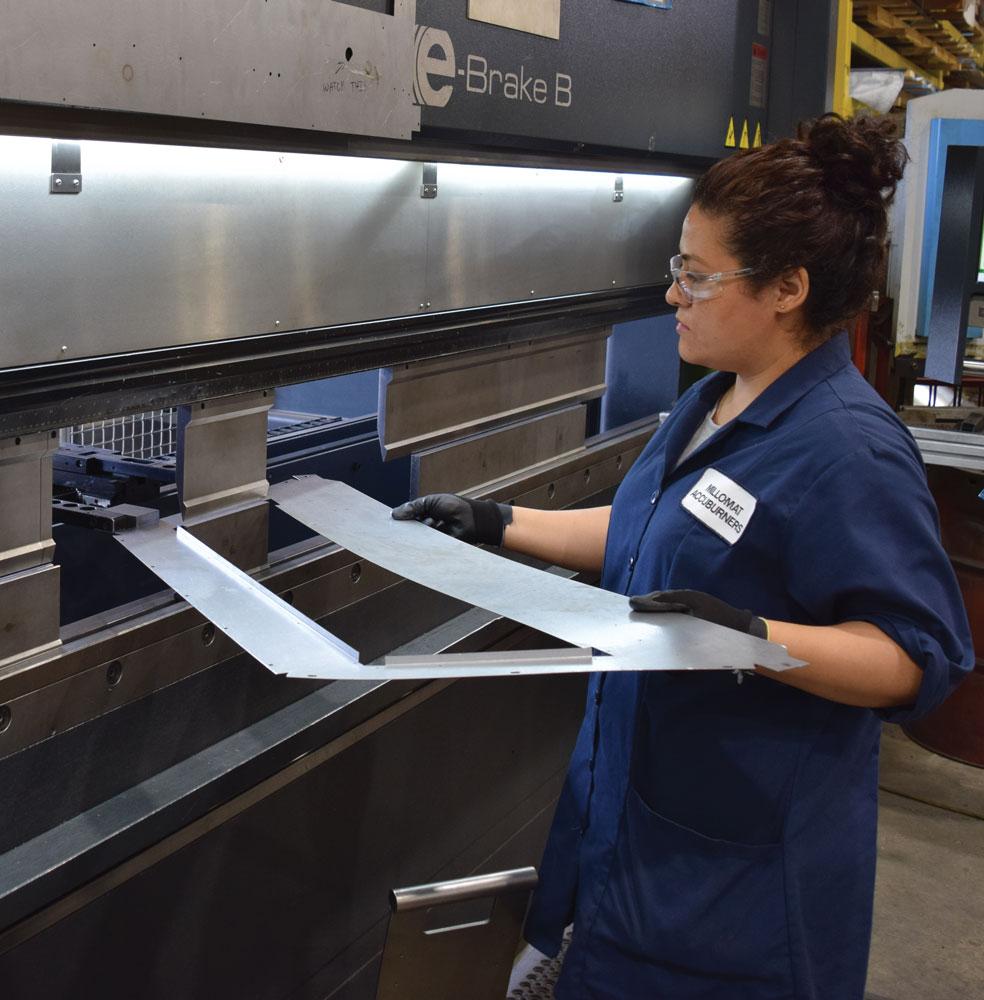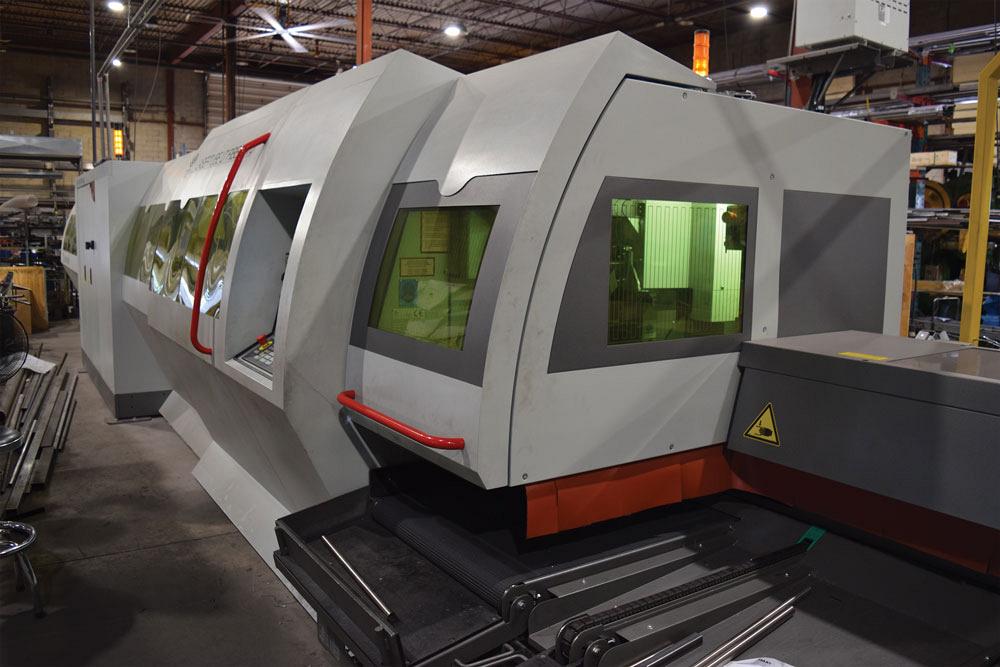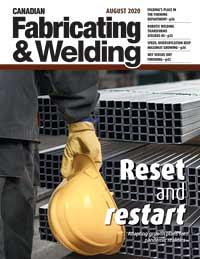Editor
- FMA
- The Fabricator
- FABTECH
- Canadian Metalworking
Speed, diversification keep Millomat growing
Mississauga shop speeds delivery times with machine investments, simplifies work process with new software
- By Rob Colman
- August 19, 2020
- Article
- Fabricating
Faster and smarter: That’s the best way to describe Millomat Stampings/Accuburners Corp.’s approach to equipment and software investments in recent years. A diversity of purchases and in-house developments in the past few years have made the Mississauga, Ont., business more versatile and capable of reacting quickly to customer needs.
Millomat was founded in 1985 as a tool and die shop by Sam Sehmbi. When they took over the daily management of the shop in 2004, Sam’s sons Mani and Junior transitioned the business into a fabricating shop driven by laser cutting capabilities. Although the company was known as a specialist in the gas appliance products sector making custom fireplace burners and manifolds, its laser capacity has expanded its potential market reach.
Junior has moved on to run Mill Finish Industries independently. Meanwhile, Mani Sehmbi has been busy diversifying Millomat’s services further. Not only has he added an 8-kW fibre laser sheet cutting machine, but he has also added a BLM LT Fiber laser tube cutting system and in-house-developed back-end software to manage inventory and work flow. But the speed of change at Millomat probably began initially with the shop’s investment in two electric press brakes.
Press Brake Upgrades
When Mani Sehmbi purchased his first SafanDarley E-Brake from Westway Machinery, a 100-3100 model, sheet production was being handled on two Mitsubishi CO2 lasers, a 3.5 kW and a 6 kW. The shop was running three shifts on these machines, and its press brakes at the time just couldn’t keep up with the volume or the complex geometries customers required.
“With the work we were getting, we had to find a new solution,” said Sehmbi. “We were getting jobs with multiple bends and some for kit processing. We had to reduce setup time, and for the type of jobs we were getting, an electric press brake made sense.”
The press brake in question is a 110-ton, 10-ft., 7-axis model. The servomotor-driven e-brake employs a belt pulley system to power the ram down.
Because the brake is equipped with 7 axes, Sehmbi knew that even complicated, multibend parts would be easily produced.
It is the speed of production, precision of the bends, and the simplicity of the controls that he appreciates most.
“I saved a lot of time on setups; the machine does a lot of the brainwork for me,” Sehmbi said. “I am doing 120-in.-long pieces on it, 12 bends per part. One part we are running has as many as 18 bends on it; in that case, we set up multiple dies on the machine to speed the processing.”
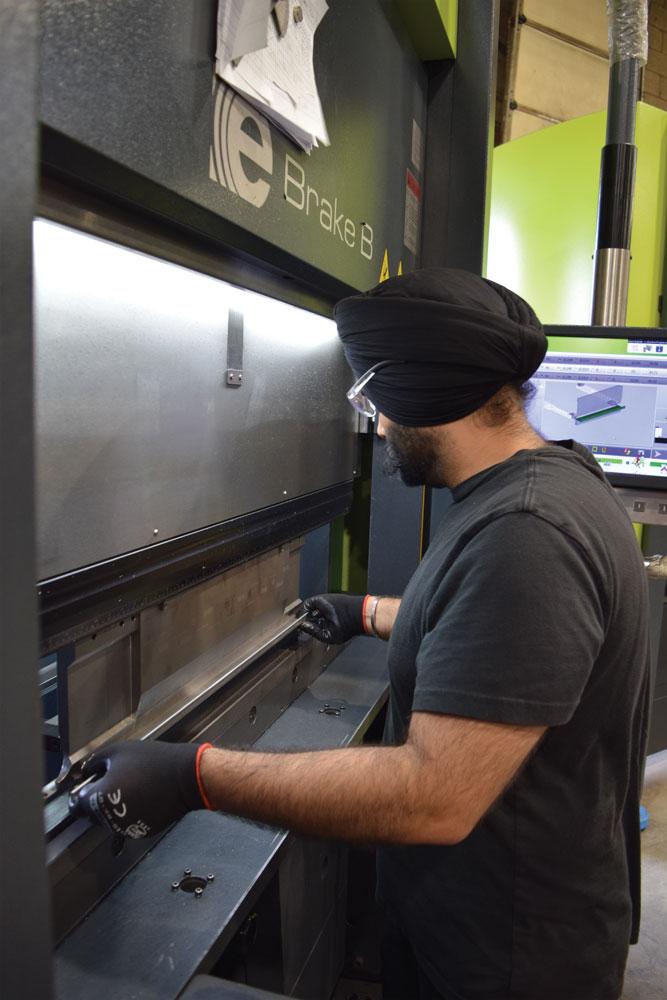
The smaller, 40-ton SafanDarley model is suitable for quick turnaround of smaller parts. Millomat owner Mani Sehmbi said, “When we did tests, we found that with the electric brake we were doing parts in half the time that a hybrid could produce them.”
Mani invested in tall tooling for that machine as well so that he could do, for example, bump bending and multiple-radii bending on a part in one setup.
As the shop had some production runs in the thousands, the efficiency and precision of the brake were welcomed.
“The challenge was that our team wanted to bend everything with more than two bends on the new press brake because it was so easy,” said Sehmbi.
To take some of the stress off that machine, and increase efficiency further in the press brake department, Sehmbi soon invested in a second SafanDarley, a 40-ton model for quick turnaround of smaller parts.
“It’s easy to turn parts around very quickly on these machines,” he said. “We do all the programming right at the brake because it is so simple. It’s not even worth doing in the office. I can literally draw, for instance, a C-channel with my finger on the control screen and the software will ask me the angles and dimensions. The machines are really smart. And with no hydraulics to worry about, maintenance is simple also.”
But the real benefit, particularly on the smaller machine, is the speed.
“I’ve considered hybrid electric/hydraulic systems, but there are delays in the bend that take time away,” said Sehmbi. “Because hydraulics are involved, you have to come down to the part about a half inch away and then the machine will stop for a second or two before coming down into the bend. You wouldn’t think that would make much of a difference, but when we did tests, we found that with the electric brake we were doing parts in half the time that a hybrid could produce them. And we’re getting accurate parts from the start, every time. The problem is, a man is not fast enough for the machine. That’s a good problem to have. The labour force education level is not so high. Nobody in the industry trains to run a brake, so having a machine that takes care of a lot of the thinking in the process for you makes the shop run smoother.”
Laser Power Push
Sehmbi knew that he wouldn’t be able to continue to compete without increasing his laser cutting capabilities. For that reason he replaced the 6-KW CO2 laser with an 8-kW fibre from Mitsubishi.
“If you cut a lot of parts and have to manage high volumes, a high-powered laser is essential,” he said. “In today’s economy, this is the machine. On my 3.5-kW CO2 I was cutting 20-ga. aluminized steel at 300 IPM. On the fibre I’m running closer to 2,000 IPM. Really fast.”
Sehmbi also invested in Mitsubishi’s Remote 360 monitoring technology, which allows Mitsubishi techs to diagnose issues on a machine remotely.
“You’ve got to have that visibility,” he said. “I probably saved $4,000 in service calls in about a half-year. If an issue happens, you just call them up and they log in to see what the issue is. So far they’ve been able to troubleshoot everything for us that way. And while they’re at it, they’ll let you know what else you might want to remedy proactively – for instance, if your chiller is low on water, they’ll suggest you top it up. It’s been a big help. I wish I could have it for every machine in our shop.”
Tube Diversification
Millomat has developed a great deal as a fab shop, but the legacy burner and manifold business has continued to deliver business.
“We do a lot of tube work for furniture as well as doing burners, and a lot of it is custom work,” said Sehmbi. “The custom work has required the purchase of a lot of dies and punches, and that can be a challenge when engineers are constantly adapting their designs. Sometimes we’ll make a die and those drawings will require a slot here, a keyhole there. Investing in dies for these only makes sense when there’s a guarantee of high volumes. And even then, the turnaround takes time, and customers are looking for faster delivery always.”
A tube laser was the ideal solution to this challenge, and Sehmbi invested in an LT Fiber EVO from BLM GROUP. The machine cuts up to 6 in. dia., a bar weight up to 15 kg/m, loads lengths of 8.5 m, and unloads lengths of 6.5 m. Millomat uses a 3-kW fibre laser.
“Now customers can order one piece and there is no tooling charge,” said Sehmbi. “We’re obviously running production on it when we can, but the flexibility is there for short-run custom work as needed. It’s impressive to watch. What BLM promotes on the machine is its software – how it loads the tube, checks the seam, the motion of the machine – it’s like watching ballet it’s so smooth.”
Work Flow Management
Like any shop investing in faster, more efficient technology, Millomat is keen to ensure work flow isn’t hindered by poor information in the front office or out on the floor. For that reason Sehmbi had his brother-in-law, a programmer, develop software to help with work flow and inventory management.
“The software is helping us catch shorted orders and waste in the cutting process,” said Sehmbi. “Our guys on the floor are now equipped with tablets. When they start a job, they open up that work order on their tablet. When they finish, they hit stop and report how many pieces have been completed. This allows us to live-check where a job is on the floor. When the job is all done, it tells us the efficiency of the job, or where efficiencies were lost. For instance, we may have programmed a part to run 5 seconds per bend but it took 8 seconds. We then sit down and determine how we lost or made money. We can then readjust quotes or processes as necessary for next time we do that job. The system will automatically readjust our quote based on production times if we want.”
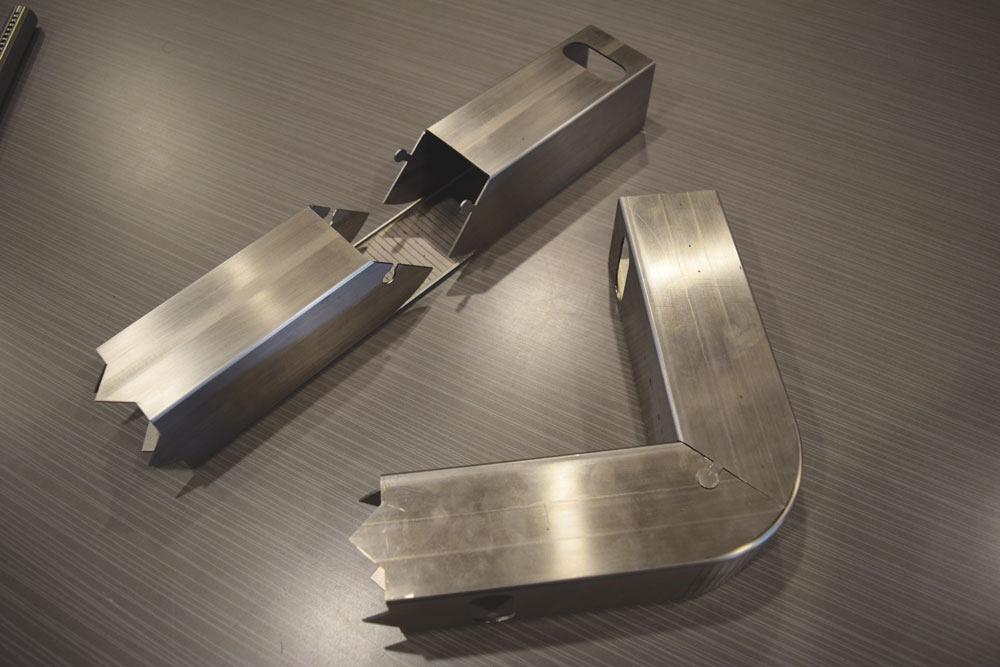
One of the values of a tube laser is how it can simplify welding setups and assemblies. Here we see a part that has been tube cut and assembly with a slot and tab arrangement to simplify weld setup and a shallow series of cuts to aid in bending.
The system also allows Sehmbi to get a quick indication of how much capacity is being used at any time. The shop’s accounting software correlates with the system and sends email confirmation to customers with a target delivery date it generates.
“The system pushes us to meet these goals,” said Sehmbi.
Post-pandemic Prep
Like a lot of shops, Millomat has been affected by the pandemic.
“We are running with about 75 per cent of our staff and working 1.5 shifts rather than our usual three,” said Sehmbi. “Luckily, we are considered an essential service for many of our customers, and that has kept us busy. The lasers and press brakes have made a big difference in getting us to where we are today.”
Sehmbi feels positive about the outlook post-COVID.
“I get the sense that business is going to get very busy. We’re doing a lot of construction-related work as well as stainless steel counters for sterile environments. The variety of work is going to help push us further once the worst of the pandemic is past us.”
Editor Robert Colman can be reached at rcolman@canadianfabweld.com.
Millomat Stampings Inc., millomat.com
About the Author

Rob Colman
1154 Warden Avenue
Toronto, M1R 0A1 Canada
905-235-0471
Robert Colman has worked as a writer and editor for more than 25 years, covering the needs of a variety of trades. He has been dedicated to the metalworking industry for the past 13 years, serving as editor for Metalworking Production & Purchasing (MP&P) and, since January 2016, the editor of Canadian Fabricating & Welding. He graduated with a B.A. degree from McGill University and a Master’s degree from UBC.
subscribe now


Keep up to date with the latest news, events, and technology for all things metal from our pair of monthly magazines written specifically for Canadian manufacturers!
Start Your Free Subscription- Trending Articles
Aluminum MIG welding wire upgraded with a proprietary and patented surface treatment technology

CWB Group launches full-cycle assessment and training program

Achieving success with mechanized plasma cutting

Hypertherm Associates partners with Rapyuta Robotics

Brushless copper tubing cutter adjusts to ODs up to 2-1/8 in.

- Industry Events
MME Winnipeg
- April 30, 2024
- Winnipeg, ON Canada
CTMA Economic Uncertainty: Helping You Navigate Windsor Seminar
- April 30, 2024
- Windsor, ON Canada
CTMA Economic Uncertainty: Helping You Navigate Kitchener Seminar
- May 2, 2024
- Kitchener, ON Canada
Automate 2024
- May 6 - 9, 2024
- Chicago, IL
ANCA Open House
- May 7 - 8, 2024
- Wixom, MI













